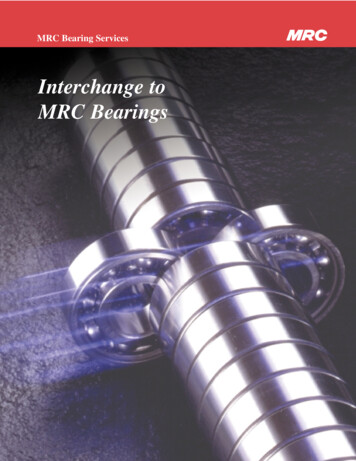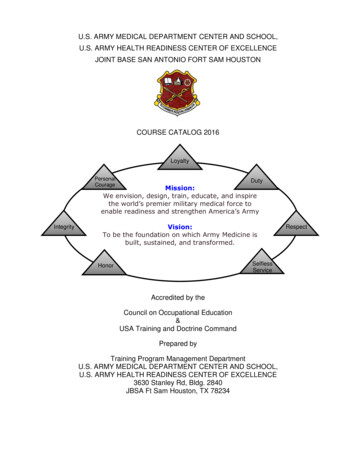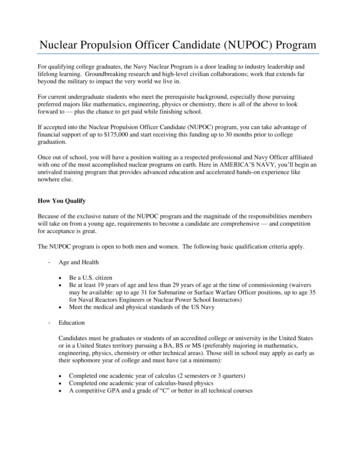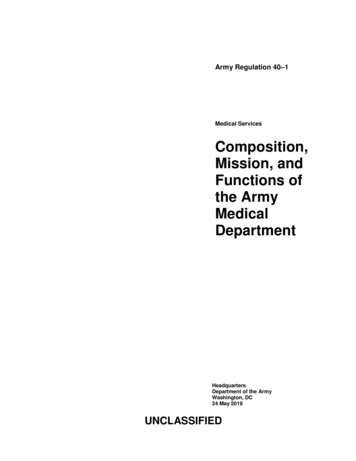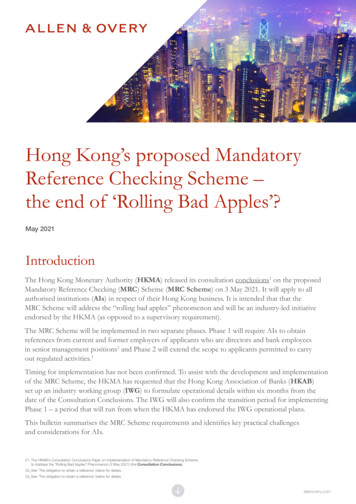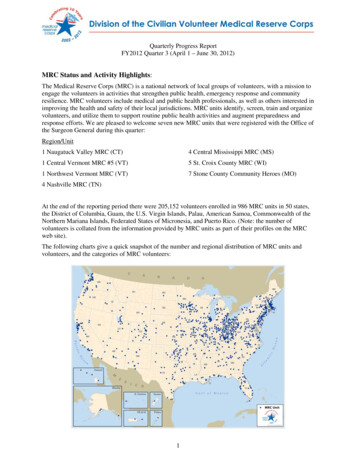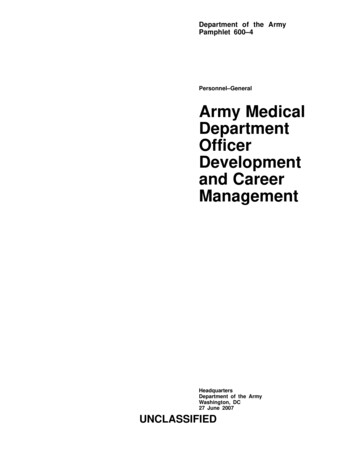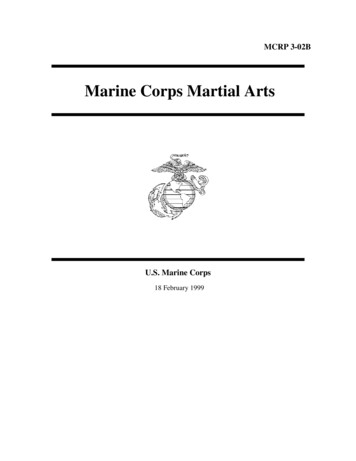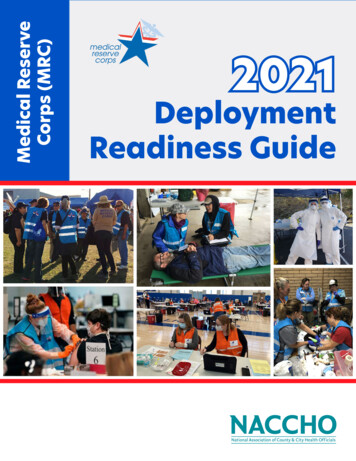
Transcription
Medical ReserveCorps (MRC)2021DeploymentReadiness Guide
MRC Deployment ReadinessTable of ContentsGlossary of Terms & Acronyms 3Introduction 5Overview of the MRC (5)MRC Deployment Readiness Project Background (5)MRC Deployment Readiness Resources (6)Deployment Readiness Volunteer Management Tools 7MRC Volunteer Tier Level Structure (8)MRC Unit Leader Deployment Readiness Checklists (9)Pre-Deployment Checklist (9)Deployment Checklist (11)Rapid Deployment Checklist (14)Post-Deployment Checklist (16)Developing Volunteer Capabilities and Baseline Training Standards 17MRC Core Competencies Overview (17)MRC Volunteer Deployment Readiness eLearnings (18)MRC Core Competencies by Learning Path (19)MRC Core Competencies Volunteer Training Plan 20Learning Path: Volunteer Preparedness (21)Learning Path: Volunteer Response (22)Learning Path: Volunteer Leadership (23)Learning Path: Volunteer Supports Community Resilience (24)Mission Sets 25COVID-19 Response Mission Sets (26)Other Common Mission Sets (30)Additional Resources (34)Conclusion and AcknowledgementsMRC Deployment Readiness Guide36[2]
MRC Deployment ReadinessGlossary of Terms & AcronymsThe following terms are referenced throughout the MRC Deployment Readiness Guide:TermDefinitionActivationMRC activation is the unit-specific process for a unit to notify volunteers of an event andthe unit’s response roles, including personnel and resources for public health activities andemergency operations.DemobilizationThe process of winding down a response, including tracking volunteers and equipment, andaddressing responder needs and experiences after a deployment.DeploymentThe deployment phase starts after an emergency occurs, includes steps to activatevolunteers and prepare them for an identified response mission, and identifiesresponsibilities during a deployment.EventA planned, non-emergency activity. The incident command system (ICS) can be used as themanagement system for events to practice and reinforce response plans. Event planningusually includes contingency plans that might occur during the event.Hot WashA facilitated discussion that is held immediately following an exercise, planned event, oremergency response and should include participants from each functional area. The hotwash is an opportunity for participants to share opinions of the exercise. It is designed tocapture feedback about any issues, concerns, or proposed improvements participants mayhave. This facilitated meeting allows players to participate in a self-assessment and providesa general assessment of how the jurisdiction performed.IncidentAn actual or impending hazard, caused by humans or by natural phenomena, requiringaction by emergency personnel to prevent or minimize loss of life or damage to property and/or natural resources.Local vs.Non-Local ResponseLocal responses are managed through the jurisdiction’s emergency management agencyin accordance with local emergency response plans. MRC Volunteers may be called uponto help support their local response plans. In some cases, MRC Volunteers may be asked tosupport an emergency response outside of their local jurisdiction as part of a mutual aidagreement or through the Emergency Management Assistance Compact (EMAC) system.Mission SetThe term ‘Mission Set’ is used to describe a scalable response and recovery capability forMRC units and volunteers that is organized, developed, trained, and exercised prior to anemergency or disaster.MRC VolunteerDeploymentThe process by which MRC volunteers receive training, are assigned a job assignment, andsupport incident response activities within the ICS structure on behalf of their MRC unit.Deployments can be local, intrastate, or interstate functions.Post-DeploymentThe post-deployment phase begins once a deployment mission has been completed andincludes activities to close out assigned mission response roles and administrative activities.Pre-DeploymentThe pre-deployment phase includes activities that happen during steady state to preparevolunteers or emergency responders for potential deployments.Public HealthEmergencyPublic health emergencies occur every day across the United States. Tornadoes, hurricanes,wildfires, floods, infectious disease outbreaks, terrorist attacks, and other emergencies havethe potential to impact the overall health of large populations of people and may require acoordinated emergency response.Rapid DeploymentThe rapid deployment phase includes activities that happen at the onset of emergenciesthat require expedited deployment.Reception AreaA location, separate from staging areas, where resources report in for processing and outprocessing. Reception Areas provide accountability, security, situational awareness briefings,safety awareness, distribution of Incident Action Plans (IAPs), supplies and equipment,feeding, and bed down.Staging AreaAny location in which personnel, supplies, and equipment can be temporarily housed orparked while awaiting operational assignment.MRC Deployment Readiness Guide[3]
MRC Deployment ReadinessThe following acronyms are referenced throughout the MRC Deployment Readiness Guide:TermDefinitionACSAlternate Care SiteASPRAssistant Secretary for Preparedness and ResponseCDCU.S. Centers for Disease Control and PreventionCERTCommunity Emergency Response TeamCOVID-19The novel SARS-CoV-2 coronavirusCRCCommunity Reception CenterDHSU.S. Department of Homeland SecurityDMPHDisaster Medicine and Public HealthEMACEmergency Medical Assistance CompactEMSEmergency Medical ServicesEOCEmergency Operations CenterESAR-VHPEmergency System for Advance Registration of Volunteer Health ProfessionalsFEMAFederal Emergency Management AgencyHHSU.S. Department of Health and Human ServicesHIPAAHealth Insurance Portability and Accountability ActIAPIncident Action PlanICSIncident Command SystemISIndependent StudyJITTJust-in-Time TrainingMRCMedical Reserve CorpsMRPMission Ready PackageNACCHONational Association of County and City Health OfficialsNDMSNational Disaster Medical SystemNIMSNational Incident Management SystemOEMOffice of Emergency ManagementPCRPatient Care ReportPFAPsychological First AidPHEMPublic Health Emergency ManagementPIOPublic Information OfficerPODPoint of DispensingPPEPersonal Protective EquipmentSARS-CoV-2Severe Acute Respiratory Syndrome Coronavirus 2MRC Deployment Readiness Guide[4]
MRC Deployment ReadinessIntroductionOverview of the MRCThe Medical Reserve Corps (MRC) is anational network of medical and non-medicalvolunteers, organized locally to improve thehealth and safety of their communities. Theprogram is housed within the U.S. Departmentof Health and Human Services (HHS), Office ofthe Assistant Secretary for Preparedness andResponse (ASPR).MRC units and volunteers are committedto strengthening public health, reducingvulnerabilities, improving local preparedness,response and recovery capabilities, andbuilding community resilience. They fill criticalpublic health emergency response resourcegaps and support the tiered model ofemergency response, with support at the locallevel first, to help offset resource requests fromthe state and/or federal level.MRC Deployment ReadinessProject BackgroundThe National Association of County and CityHealth Officials (NACCHO) designed the MRCDeployment Ready Project in 2019 to supportthe MRC priorities outlined by the ASPR. Theproject was intended to support the integrationand deployment of the MRC in local and multijurisdictional medical/public health emergencyresponses and identify or develop tools,resources, and recommendations for nationalstandards for volunteer deployment readiness.NACCHO was assisted in the development oftools included in the initial 2019 DeploymentReadiness Guide by seven MRC units andmembers of the NACCHO MRC Advisory Group.MRC Deployment Readiness GuideMRC units train their volunteers to meetstandardized core competencies andmission specific emergency responses tosupport their local community needs. Thesetraining efforts: Support the integration of local MRCunits into emergency preparedness,response, and recovery activities; Advance a unified and systematicapproach to improve the health, safety,and resiliency of local communities,states, and the nation; and Reduce disaster risks by maximizing acommunity-wide approach to resourceavailability.NACCHO MRC Advisory Group: The NACCHOMRC Advisory Group, which includesrepresentation of the greater MRC network,provided invaluable contributions to thedevelopment of resources within this guide. Theycontributed to the development of Mission Setsand provided recommendations on volunteerdeployment readiness tier levels, training coursesto support the MRC core competencies, andthe development of online short courses forvolunteers to prepare for emergency responsedeployments.[5]
MRC Deployment ReadinessMRC Deployment ReadinessResourcesThe MRC Deployment Readiness Guides eachprovide a common set of tools for MRC unitleaders to develop the capabilities of theirMRC volunteers to support medical and publichealth emergency responses. Both the 2019 and2021 guides, along with any future guides andnovel deployment readiness resources, will behoused on NACCHO's MRC webpage (bit.ly/NACCHOMRC).The tools included in this guide provide anational recommended standard that canalso be modified to fit the unique mission ofindividual MRC units. These standards can alsobe shared with emergency response partners todemonstrate the capabilities of MRC volunteers.The guide includes resources and tools to supportthe following deployment readiness activities:MRC Deployment Readiness GuideVolunteer Management MRC Deployment Readiness VolunteerTier Levels MRC Unit Leader Deployment ReadinessChecklistsDevelop Volunteer Capabilities MRC Core Competencies Training Plan MRC Volunteer Deployment ReadinesseLearning ModulesDevelop Unit Capabilities Emergency Response “Mission Sets”The MRC Deployment Readiness Guide andtools included in the guide are available on theNACCHO MRC webpage at bit.ly/NACCHOMRC.[6]
MRC Volunteer ManagementDeployment ReadinessVolunteer ManagementToolsMRC units should ensure that volunteers meet theappropriate administrative actions and just-intime training (JITT) role-specific training requiredprior to volunteer activations or deployments.Managing MRC volunteer activities to buildresponse capabilities starts with the volunteerapplication process and continues withvolunteer onboarding and integration into MRCunit activities. Understanding the activities,training, and administrative actions necessary toprepare volunteers for potential activations anddeployments will help MRC unit leaders developa plan to build their unit response capabilities. Itis also important to understand a unit’s capacityto respond based on the levels and training ofthe volunteers. This resource guide providestwo tools for MRC unit leaders to manage theirMRC volunteers from a deployment readinessperspective.MRC Unit Leader DeploymentReadiness ChecklistMRC Volunteer Tier Level StructureThe MRC volunteer tier levelstructure provides arecommendation forstandardizing MRC volunteerdeployment readinesscapabilities based on levels ofemergency response experience,training, exercises, unit activities,and activations/deployments.MRC units can use theserecommended levels to identifyvolunteers that meet the criteriaby level to help them understandthe capacity of their unit torespond to non-mission-specificresponses. Role-specific trainingrequirements would also be afactor to determine volunteerand unit capacity to respond.MRC Deployment Readiness GuideThe MRC Unit Leader Deployment ReadinessChecklist provides unit leaders with a checklist ofactivities that should happen during the phasesof a deployment: Pre-deployment, Deployment,Rapid Deployment, and Post-deployment. Therecommendations were compiled with inputfrom the NACCHO MRC Advisory Group and theMRC Deployment Ready Pilot sites. This checklistis by no means exhaustive but covers a broadspectrum of topics including administration,liability coverage, screening, verification ofmedical licensure, safety and medical clearance,training, cultural competency, and responseoperations.Deployment ReadinessVolunteer Management ToolsMRC VolunteerTier LevelsTiers basedon training &experienceHelps identifynon-missionspecificcapacity torespondMRC Unit LeaderDeploymentChecklistChecklist ofactivities ,& safetyactivities[7]
MRC Volunteer ManagementMRC Volunteer Tier Level StructureThe following chart provides a recommendation for standardizing MRC volunteer tier levels basedon level of emergency response experience, training, exercises, unit activities, and activations/deployments. MRC units should also ensure that volunteers meet the appropriate administrativeactions and JITT role-specific training required prior to volunteer activations or deployments.MRC Volunteer Tier LevelsLevelMRCLevel 1MRCLevel 2Deployable EMAC/Federal Intrastate Local Intrastate LocalLevel DescriptionLevel 1 Volunteers: Meet the standards for Level 2 Demonstrated experience in nonemergency activations or emergencydeployments Capable of serving supervisory roles Background check recommended& may be required for EMACdeploymentsTrainingRequired: IS-200IS-800Recommended:MRC Core CompetenciesLearning Paths Volunteer LeadershipCommunity ResiliencyRequired:Level 2 Volunteers: IS-100 Meet the standards for Level 3 IS-700 Demonstrated experience throughtraining/exercisesRecommended: Demonstrated participation in unitMRC Core Competenciesactivities and non-emergency events Learning Path Background check recommended Volunteer ResponseRequired:MRCLevel 3 LocalLevel 3 Volunteers: Limited training or participation inunit activities Background check recommended Recommended:MRC Core CompetenciesLearning Path MRCLevel 4 Local surgeresponse onlyUnassigned Non-deployableMRC Deployment Readiness GuideMRC Unit Orientation or JITTequivalentVolunteer PreparednessLevel 4 Volunteers: Registered with the MRC but have not completed MRC unit onboarding process or orientation Can be deployable during a local emergency surge response, ifthey receive a JITT orientation, role-specific JITT, and meet rapiddeployment on-boarding requirements. Spontaneous or volunteers from other volunteer organizationsVolunteers would need to register with the MRC unit and meet Level 3requirements to be deployable[8]
MRC Volunteer ManagementMRC Unit Leader Deployment Readiness ChecklistsThis checklist of activities is designed to guide MRC Unit Leaders through the phases of adeployment: Pre-deployment, Deployment, Rapid Deployment, and Post-deployment. The followingrecommendations are by no means exhaustive but cover a broad spectrum of topics includingadministration, liability coverage, screening, verification of medical licensure, safety and medicalclearance, training, cultural competency, and response operations.Pre-Deployment ChecklistThe pre-deployment phase checklist includes activities that happen during steady state to preparevolunteers for potential deployments.PRE-DEPLOYMENT PHASEAdministration Ensure all volunteers complete an MRC application that includes a minimum of the following items:address (physical and mailing), phone number, email, profession, and opt-in text notifications. Additionalitems, such as previous training, certifications, health profession status, health limitations, etc., may beincluded. See sample application.Provide MRC policy and guidance documents with written volunteer acknowledgement.Document and ensure volunteers understand the notification process and deployment expectations.See sample activation process.Ensure all volunteers have been issued an MRC badge and uniform.Liability Coverage Ensure volunteers sign local and/or state loyalty oath and/or the MRC unit’s code of donductagreement.Provide information on liability coverage. See Centers for Disease Control and Prevention (CDC) PublicHealth Emergency Law (PHEL) Online Course (Unit 2) or the Emergency Law Inventory.Screening All volunteers should undergo background checks, as resources allow. Consult your legal counselregarding standards and process.If your unit has deployment disqualification conditions, make certain each applicant is clear of thoseconditions. See pre-deployment questionnaire.Verifying Medical Licenses Ensure health professional MRC volunteers are registered via Emergency System for AdvanceRegistration of Volunteer Health Professionals (ESAR-VHP) or other credentialing software.Periodically verify all medical credentials. If a license is to expire soon (or within anticipated deploymentdate), flag for follow up prior to expiration.MRC Deployment Readiness Guide[9]
MRC Volunteer ManagementPRE-DEPLOYMENT PHASE (cont'd)Training MRC unit orientation. See sample orientation presentation. For baseline volunteer training recommendations, please see MRC Volunteer Tiers (p. 8), MRC CoreCompetencies (p. 17), MRC Core Competencies Volunteer Training Plan, and a sample training plan. Conduct skills assessments as needed for specific roles (e.g., vaccinators).Document all training activities including dates and duration. Recommended training includesIS-100, IS-700, CPR/First Aid/AED, Psychological First Aid (PFA), Stop the Bleed , cultural competency, andpersonal protective equipment (PPE) training.Safety and Medical Clearance Conduct risk assessments for ALL events and deployments, to include health risks. See ICS-215A. Volunteers should keep copies of immunization records, which may be requested prior to deployments. If immunizations and assessments are required, schedule regular opportunities for volunteers to receive them.Consider offering free screening and immunizations to parents/family members, if resources allow. Ensure PPE is available, volunteers are trained on donning and doffing procedures, and N95 fit testing hasbeen completed. Ensure a safety briefing is included in all activities.Have all volunteers complete health/screening statements. This can take many different forms but is primarilyintended to match volunteer roles appropriately with physical demands of deployment missions. See samplesafety survey and pre-deployment questionnaire.Ensure you have written policy for required immunizations and assessments, including disqualifyingconditions, exceptions, and opt-out conditions. Consider alternate assignments if volunteers are disqualified.See this guide from South Central MRC (PA) for more health and safety considerations.Cultural Competency Identify volunteers who self-report language competencies. Consider additional training regarding ethics, sensitivity, “bedside manner,” and social media sensitivity indisaster settings.Strengthen cultural competencies, including cultural health literacy and health equity, through culturalhumility training, cultural competency training, etc.General Response Operations Provide a deployment checklist during orientation. Send supplements for specific incidents, if needed.Examples include: ReadyBrazoriaCounty AppOrientation SlidesActivation EmailQuick Series - Deployment GuideQuick Series - PFA Field Operations GuideRemind volunteers to have a completed family emergency plan in place.Remind volunteers to maintain a basic, personal go-bag and update it regularly. See go-bag checklist.MRC Deployment Readiness Guide[10]
MRC Volunteer ManagementDeployment ChecklistThe deployment phase starts after an emergency has happened and includes steps to activatevolunteers, prepare them for an identified response mission, and assign responsibilities during adeployment.DEPLOYMENT PHASEAdministration Begin alert/activation procedures to notify volunteers. See sample activation email and sampleactivation process.Document all volunteer activity during deployment including hours, signature, location, and date(s).Complete deployment tasks: Identify mission number.Send team activation notification to state and region. See ICS-205A and ICS-204.Complete rosters and numbers.Maintain activity log: See ICS-214.Track volunteer participation with sign-in sheets.Complete key documentation, including patient care reports (PCRs) and clinic operations reportfor the operational area (OA).Send each team with a deployment binder.Fill out an incident check-in list. See ICS-211.Liability Coverage Review your state’s Good Samaritan laws. See Oklahoma Good Samaritan Law, as en example.For mutual aid requests, obtain a resource request and/or mission assignment.Confirm volunteer liability coverage once activated. See the Emergency Law Inventory.Re-verify the loyalty oath and any other credentials prior to leaving the staging area.Be aware that there may be laws enacted for additional liability coverage for volunteers during anemergency.Screening Background checks are highly recommended for all volunteers. Establish a memorandum ofunderstanding (MOU) with the police or sheriff’s office in advance to complete expedited backgroundscreenings for immediate deployments. Re-verify and document professional licenses prior to activation or deploy as non-medical.MRC Deployment Readiness Guide[11]
MRC Volunteer ManagementDEPLOYMENT PHASE (cont’d)Safety and Medical Clearance Ensure all immunizations and assessments are complete and document or offer updates.Volunteers should maintain their own records.Maintain needed claims paperwork on-site in the deployment binder in the event of injury.Complete comprehensive risk assessment PRIOR to any deployment.Be on alert for any accidents or injuries. Have volunteers report up their chain of command.Ensure volunteers have PPE for specific mission.Be alert for accidents, injuries, and signs of stress or mental fatigue in volunteers.See this guide from South Central MRC (PA) for more health and safety considerations.Training Provide JITT MRC orientation as needed for new volunteers.Provide JITT for all responders to cover roles and mission response information.Provide deployment briefing to address specifics of the response including the current situation,objectives, expectations, and incident-specific policy. See following references: Orientation/Core CompetenciesExamples of JITTActivation EmailProvide volunteers with a deployment packet with ICS forms, job action sheets, communicationsprocesses, and check-in/check-out process.Volunteers should be prepared to participate in situational briefings, as well as safety briefings (i.e., tourof work site, facilities, lodging), daily debriefs (i.e., documentation expectations), and hot wash.Cultural Competency Collect information about response areas before deploying (e.g., Census data). Ensure all documents are available in common languages for survivors.Include cultural challenges and strategies in briefings.Review cultural competency needs during the deployment and provide additional cultural competencytraining opportunities, if needed. See MRC Core Competency 8.0 (p. 23) for suggested courses.Review each volunteer’s past performance before deployment.MRC Deployment Readiness Guide[12]
MRC Volunteer ManagementDEPLOYMENT PHASE (cont’d)General Response Operations Ensure unit leaders receive incident management situational (sit) report and missions details. Sharepertinent information with volunteers.Continue to attend briefings for situational awareness.Ensure necessary equipment/resources are available to perform duties and returned after use, includingany necessary PPE, based on deployment criteria/roles.Understand staffing requirements and develop plans for shift coverage, including extendeddeployments or 24-hour operations.Provide deployment details to all deploying volunteers via the MRC coordinator.Ensure that all deployed volunteers are properly briefed before each shift. See ICS-201.Maintain deployment rosters for check-in and check-out to ensure accountability and tracking ofvolunteer hours.Conduct daily or periodic operational briefings to maintain open communications and situationalawareness.Have a plan for demobilization of volunteers for extended deployments.Consider adding a volunteer liaison at deployment sites to coordinate with unit leaders when they'renot on site. See this Mission Set from Oklahoma Region 7, Tulsa MRC for an example of a volunteercoordinator liaison.MRC Deployment Readiness Guide[13]
MRC Volunteer ManagementRapid Deployment ChecklistRapid-deployment phase checklist includes activities that happen during not steady state to preparenew volunteers for potential rapid onboarding and rapid deployments.RAPID DEPLOYMENT PHASEAdministration Ensure all volunteers complete an MRC application that includes a minimum of the following items:address (physical and mailing), phone number, email, profession, and opt-in text notifications. Additionalitems, such as training, certifications, health professional status, health limitations, etc. may be included.Ensure all volunteers have been issued an MRC badge, vest, and/or uniform.Document all volunteer activity during deployment including hours, signature, location, and date.Complete deployment tasks listed in the Deployment Checklist (p. 11).Liability Coverage Ensure volunteers sign local and/or state loyalty oath and/or the MRC unit’s code of conduct agreement.Provide information on liability coverage.Confirm volunteer liability coverage once activated.Screening Basic background checks are highly recommended for all rapid volunteers.Have all volunteers complete health/screening statements.Verifying Medical Licenses Verify all medical credentials immediately prior to deployment. If a license is to expire soon (or withinanticipated deployment date), flag for follow-up prior to expiration.Training Provide JITT MRC orientation.Provide JITT for all responders to cover roles and mission response information.For baseline volunteer training recommendations, please see MRC Volunteer Tiers (p. 8) and MRC CoreCompetencies (p. 17).Safety and Medical Clearance Conduct risk assessments for ALL events and deployments, to include health risks. See ICS-215A.Ensure a safety briefing is included in all activities.Be on alert for any accidents or injuries. Ensure volunteers understand procedures for reporting injuries.Cultural Competency Identify volunteers who self-report language competencies. Include cultural challenges and strategies in briefings.Based on the need of each mission, consider additional JITT training regarding ethics, sensitivity,“bedside manner,” and social media sensitivity in disaster settings.MRC Deployment Readiness Guide[14]
MRC Volunteer ManagementRAPID DEPLOYMENT PHASE (cont’d)General Response Operations Provide volunteers with reporting details, ensuring they bring appropriate personal items (i.e., go-bag)for deployment.Provide volunteers with a deployment packet with ICS forms, job action sheets, communicationsprocesses, and check-in/check-out process.Ensure necessary equipment/resources are available to perform duties and returned after use, includingany necessary PPE, based on deployment criteria/roles.Conduct daily or periodic operational briefings to maintain open communications and situationalawareness.Conduct daily or periodic hotwashes/debriefing to address an operational issue on-site and makeappropriate changes.MRC Deployment Readiness Guide[15]
MRC Volunteer ManagementPost-Deployment ChecklistThis phase begins once a deployment mission has been completed and includes activities to close outassigned response missions and administrative activities for MRC volunteers and the MRC unit.POST-DEPLOYMENT PHASEAdministration Begin demobilization procedures and notify volunteers. See sample demobilization process anddemobilization email.Complete post-deployment administrative tasks including: Collection of activity logs (i.e., ICS-214) and sign-in sheets.Paperwork such as PCRs.Rehab of equipment cache.Team debrief and hot wash.Volunteer evaluations.Unit/responder recognition.Collect volunteer hours and report these to the MRC Unit Profile & Activity Reporting System.Capture all documentation developed during deployment and catalog/store for future use. Electronicdata should be backed up and archived.Capture debrief data and conduct verbal and written debriefs to capture best practices/lessons learned.Apply best practices and lessons learned to update plans and procedures.Liability Coverage If needed, follow up on any potential claims/cases and document updates.Safety and Medical Clearance Have volunteers conduct self-assessments. See sample post-deployment questionnaire. Share self-care reminders and recommendations to deployed volunteers. Hold a debrief to check in with volunteers via email/phone call after deployment and offer mental healthsupport, if needed.Monitor responders for illness if there was an issue (e.g., Instruct volunteers to report any GI illness thatoccurred in last 48 hours).See this guide from South Central MRC (PA) for more health and safety considerations.Cultural Competency During the debrief, ask about cultural competency strengths and areas for improvement.General Response Operations Thank all volunteers for their service during a deployment (e.g., emails, calls, local news, social media,etc.).Hold a debrief/hot wash process with all deployed volunteers.Document deployment successes, challenges, and lessons learned in an after-action report andimprovement plan.See Tulsa (OK) MRC's post-deployment review.MRC Deployment Readiness Guide[16]
MRC Core CompetenciesDeveloping VolunteerCapabilities and BaselineTraining StandardsThe competencies are aligned into four M
Pre-Deployment Checklist(9) Deployment Checklist (11) Rapid Deployment Checklist (14) Post-Deployment Checklist (16) Developing Volunteer Capabilities and Baseline Training Standards _ 17 MRC Core Competencies Overview (17) MRC Volunteer Deployment Readiness eLearnings (18) MRC Core Competencies by Learning Path (19) .
